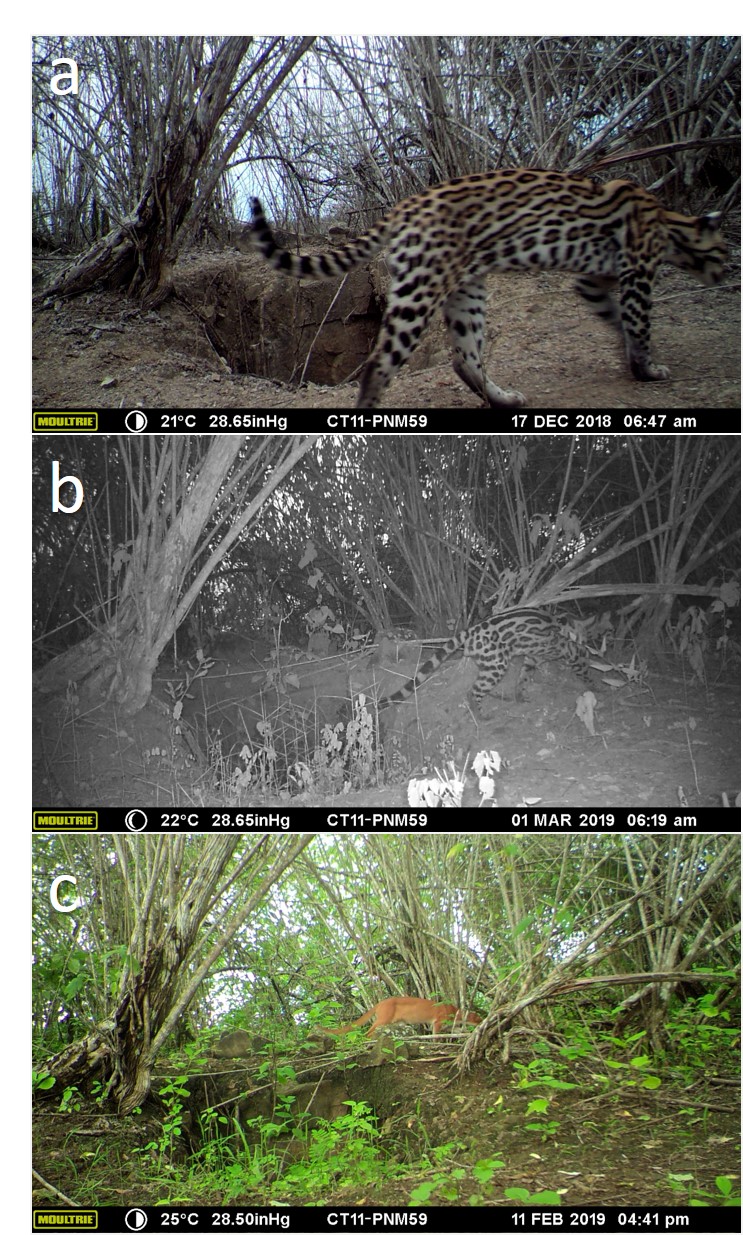Abstract
The Machalilla National Park (PNM) located in the Tumbes-Chocó-Magdalena hotspot in western Ecuador, contains high levels of biodiversity and endemism; however, it presents a constant loss and degradation of its habitat due to anthropogenic activity. In this work, the presence of wild cats within the protected area of the PNM was determined. 60 trap cameras were located within the 56,184 ha of the PNM land area, between the months of October 2018 and February 2019. During this period, the presence of three species of wild cats was detected: ocelot (Leopardus pardalis), margay (Leopardus wiedii) and yaguarundí (Herpailurus yagouaroundi). This note presents a particular case in which the presence of the three feline species was reported coinciding in one of the trap chambers
References
Briones-Salas M, Lira-Torres I, Carrera-Treviño R, Sánchez-Rojas G. 2016. Relative abundance and activity patterns of wild felids in Chimalapas rainforest. Oaxaca, Mexico. Therya. 7, 123-134.
Carrera-Treviño R, Astudillo-Sánchez Cl, Garza-Torres H, Martínez-García L, Soria-Díaz L. 2018. Inter-acciones temporales y espaciales de mesocarnívoros simpátricos en una reserva de biosfe-ra: ¿convivencia o competencia?. Revista de Biología Tropical. 66, 996-1008. https://dx.doi.org/10.15517/rbt.v66i3.30418
Ceballos G, Garcia A, Ehrlich PR. 2010. The sixth extinction crisis: Loss of animal populations and species. Journal of Cosmology, pp. 1821-1831.
Cervera L, Lizcano DJ, Parés V, Espinoza S, Poaquiza D, De la Montaña E, Griffith D. 2016. A camera trap assessment of terrestrial mammals in Machalilla National Park, western Ecuador. Check List. 12, 1868. http://dx.doi.org/10.15560/12.2.1868
Clavijo A, Ramírez F. 2009. Taxonomía, distribución y estado de conservación de los felinos surame-ricanos: revisión monográfica. Boletín Científico Centro de Museos. Museo de Historia Na-tural, pp. 43-60.
Di Bitetti M, De Angelo C, Di Blanco Y, Paviolo A. 2010. Niche partitioning and species coexistence in a Neotropical felid assemblage. Acta Ocologica. 34, 403-412. https://doi:10.1016/j.actao.2010.04.001
Kiltie RA. 1984. Size ratios among sympatric neotropical cats. Oecologia. 61, 411 416. https://doi.org/10.1007/bf00379644
Kolowski JM, Alonso A. 2010. Density and activity patterns of ocelots (Leopardus pardalis) in northern Peru and the impact of oil exploration activities. Biological Conservation. 143, 917-925. https://doi.org/10.1016/j.biocon.2009.12.039
MAE. 2017. Deforestación del Ecuador continental periodo 2014-2016. Quito, Ecuador: Ministerio del Ambiente.
Ortega-Andrade HM, Prieto-Torres DA, Gómez-Lora I, Lizcano DJ. 2015. Ecological and Geographical Analysis of the Distribution of the Mountain Tapir (Tapirus pinchaque) in Ecuador: Im-portance of Protected Areas in Future Scenarios of Global Warming. PLoS ONE 10(3): e0121137. https://doi.org10.1371/journal.pone.0121137
Payán-Garrido E, Soto-Vargas C. 2012. Los Felinos de Colombia. Ministerio de Ambiente y Desarrollo Sostenible, Instituto de Investigaciones de Recursos Biológicos Alexander von Humboldt y Panthera Colombia. pp. 48.
Pérez-Irineo G, Santos-Moreno A. 2014. Abundancia y patrones de actividad de felinos medianos (Felidae, Carnivora) en el sureste de México. The Southwestern Naturalist. 61, 33-39.
TEAM Network. 2011. Terrestrial Vertebrate Protocol Implementation Manual, v. 3.1. Arlington: Tropical Ecology, Assessment and Monitoring Network, Center for Applied Biodiversity Science, Con-servation International.
Tirira DG, Brito J, Burneo SF, Moreno P, Pinto CM. 2019. Mamíferos del Ecuador: lista actualizada de especies / Mammals of Ecuador: Updated checklist species. Versión 2019.1. Asociación Ecuatoriana de Mastozoología. Quito, Ecuador. http://aem.mamiferosdelecuador.com (ac-tualización / updated: 2019-09-30).

This work is licensed under a Creative Commons Attribution-ShareAlike 4.0 International License.






